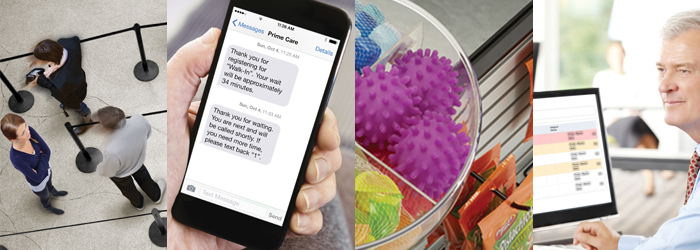As online shopping continues to threaten in-store sales, brick-and-mortar retailers are stepping up to gain a better understanding of how people perceive waiting lines. A 2011 article from The Wall Street Journal featured some very interesting research on the waiting line imperative. Here are some of the most intriguing findings:
It’s all about me
Shoppers are unlikely to consider what’s slowing down a line; only that it’s affecting the length of their wait, and impatience comes quickly. If a line isn’t moving fast enough for a customer’s tastes, they’re likely to abandon it after only two or three minutes. Remorse is common too, when people feel they’ve chosen the “wrong” line.
Lavi takeaway: Consider implementing an
electronic queuing system to provide consumers with an estimate of how long they’ll be waiting. Informed customers are happier customers.
Shoppers want to choose
Though research has proven that a single-line, multiple-server queue is faster, many customers still prefer to choose their own line rather than wait for the next available register (thus the remorse – it’s a vicious cycle).
Lavi takeaway: You know what’s best for the traffic patterns and shopping patterns of your store. Construct the line so that it works speedily and efficiently.
From accurate to inflated
Up to a two- or three-minute wait, customers maintain a very accurate perception of how long they have actually been standing in line. However, after three minutes, all bets are off. The perceived wait time increases with every passing minute, feeling like double the wait by the time five minutes roll around.
Lavi takeaway: This statistic again proves the point that the perceived wait is just as important – if not more so – than the actual wait. Make a customer’s time in the queue enjoyable by incorporating in-line merchandising and digital media to keep them entertained and distracted.
The end is what matters
The feeling of stress decreases for customers when an employee or electronic screen is placed near the front of the line, directing shoppers to the next open register. The end of the line is actually an important indicator of satisfaction – shoppers tend to put more weight on a line’s speed toward the end of their wait. Even if a line moved quickly at the start, the end is what’s remembered and influences positive or negative feelings about the experience and the store as whole.
Lavi takeaway: A single-line queue feeding multiple stations keeps the line flowing at all points – the beginning, the middle, and the end. If one checkout station slows down, the next customer in lines simply moves to the first available station.
Appearances can be deceiving
Customers tend to be more attracted to shorter lines rather than observing how quickly a line is moving. But the catch-22 is that a short line may be short for a reason – the person at the front of the line has too many items, needs a price check, or the line has a slow or chatty cashier. And none of those elements make for happy consumers.
Lavi takeaway: Publishing average wait times for each queue gives customers the facts they need to make an informed decision. And it’s proven that a finite wait seems shorter than an unknown wait.
People like to shop, shop, shop
In-line merchandising has always been a staple at grocery stores – tabloids, candy bars, drinks. But stores like Old Navy have upped the ante, with chock-a-block displays showing off in-queue wares like glittery piggy banks, Hello Kitty everything, and retro lunch boxes, making it truly feel like you’re shopping more than waiting in line.
Lavi takeaway: In-line merchandising is always a wise option, increasing impulse sales and distracting people as they wait.
The gender role
Men are more likely to give up on a line than women. Guys are also faster to inflate the amount of time they’ve spent in a line – with gents it only takes two minutes, with women the time begins to inflate after three minutes.
Lavi takeaway: Well, we’re not about to get into the Mars vs. Venus debate…
An especially crucial piece of information gleaned from the WSJ article is that a recent research project came to the following conclusion, confirming what we at Lavi already knew: A single-file line that leads to three cashiers is around three times faster than three separate lines for three separate cashiers. Talk to an expert about how to revamp your retail queue today to accommodate the habits of your customers and the needs of your business.










